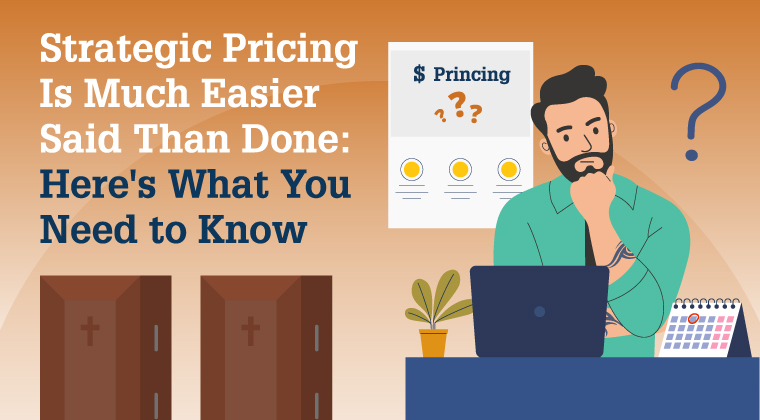To run a successful funeral home, you need to hone your pricing strategy. Exceedingly low prices — while attractive to families — prevent you from turning a profit. On the other hand, over-inflated prices can prevent families from selecting a service altogether as they seek out more affordable options.
To create the optimal prices for your services, you’ll need to holistically examine your costs, how they compare to the greater market, and how they impact your clientele.
Understand Your Costs
It goes without saying that your revenue must exceed your costs; however, many funeral businesses fail to fully understand the full picture of their operating expenses.
In order to calculate these costs, you’ll need to create a budget and review your financial statements for the last three full years. To get started, add up the direct costs of goods sold (COGS). This includes all of the costs associated with providing each of your services. You’ll also want to consider more general expenses, including rent, payroll, maintenance, marketing, and any recurring debt payments.
From this, you’ll be able to clearly understand the bare minimum your business requires to function and how much it needs to recoup in order to be profitable.
Understand the Market
In recent years, cremations have surpassed traditional burials in terms of popularity, a trend that is only expected to continue. While factors fueling the popularity of cremation are likely varied, one can only assume that price plays a role. The average cost for a funeral and burial falls just under $9,500, while the average direct cremation costs just over $3,500.
It’s expected that you would understand how your prices compare to your competition. Be sure that you’re not stuck in the middle of the value equation. It’s certain that there are two types of customers that exist for a funeral business: One is the customer that appreciates the high value and complete list of services that funeral business provides; and the second customer is looking to save as much money as they can with no frills involved (the low cost shopper). It’s important for you to determine which one of these you will be, making sure that you are not competing against both with one brand.
Offer Flexibility
Within your funeral home’s service offerings, it’s always best to offer three to five different tiers of packages. Known as price anchoring, this process helps clients understand what they can expect to pay for different levels of service.
While seeing a single expensive service listed might give a person sticker shock, a variety of options provides additional context for pricing and allows a wider range of people to pick an option within their budget.
Regardless of the tier of service a family chooses, your business should also offer optional add-ons that allow families to customize their service. However, within these add-ons, you’ll want to keep the options simple. Too much complexity can confuse families, or worse, cause them to feel like they’re being “nickel and dimed”.
Expert Help with Funeral Home Strategic Pricing
To create an effective funeral home strategic pricing plan, you’ll need to carefully balance the needs of your families with the costs of running your business — not to mention keeping a careful watch over the competition. Naturally, balancing all of these considerations can get complicated, making it worthwhile to seek the help of experts.
At Johnson Consulting Group, our team of funeral home consultants and accountants can help you develop a pricing strategy that drives your business forward. Through a holistic analysis of your funeral home’s performance in relation to the greater marketplace, we’ll help you identify opportunities to improve your pricing structure and streamline your operational costs.
When running a funeral business, it’s often difficult to get a clear view of how your business performs, and our consultants can provide the objective insight that propels your business through the new year.
